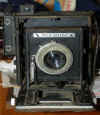| 02-16-04
There are times in the great outdoors when one's success is measured
by failures.
Such was the case many years ago when I wrote an outdoors column and
doubled in brass as a police reporter for the state's largest and best
newspapers.
My days off were Sundays and Mondays, and I often was assigned to "outdoorsing"
on Tuesdays. The "outdoorsing" term was coined by my editor who wanted
me to be out there doing something, even though he had not the foggiest
notion of what it would be.
Sundays were pretty much occupied by family things and puttering around
the house, but Mondays and Tuesdays brought a middling chance that I would
be in the boonies or on a creek, river, pond, lake, or all of those neat
environments.
But there still was a problem. Cy McBride, my editor and schedule maker,
liked to have pictures with my stuff--even action shots of me doing something.
One day after I had written a column about bass fishing, Cy told me
he would like some pictures of me catching a fish. He wanted me in the
foreground and the fish doing something like jumping out of the water in
the background.
"Vice versa is OK if that's easier," Cy said.
That brought an inherent problem. My outdoors friends had to work on
week days and everyone knows that taking action shots is much akin to marital
squabbles and dancing: It takes two to tangle or tango.
I had no problems with catching bass, bluegills and other denizens of
the deep. And I could shoot pictures of dead fish without end. But how
would I get action shots of myself in fish-catching situations.
During my police-reporting days I had been required to carry one of
the old Speed Graphic cameras which shot 4 X 5-inch cut film that was stored
in holders that slipped into the back of the camera. There was one piece
of film on each side of the holder. All I had to do was slip the holder
in the back slot of the camera, remove a protective slide and fire away.
It was slow and it was cumbersome, but the old Speed Graphic press-type
cameras made great pictures with huge negatives. Thirty-five millimeter
cameras and roll film were trying to slip into the periodical print at
that time, but most editors would not touch them with a 10-foot pole. I
had found the company camera I carried so useful that I had purchased a
used Graphic for my own personal use.
Although first thoughts of my assignment assured me my job would not
be easy, I had some ideas on the matter.
"How would it be if I could place the camera pre-focused on a tripod,
step into the picture, make a cast, hook a bass and trip the shutter to
record the whole schemer on a piece of film?"
"But how," I asked myself, "would I trip the shutter?"
The Speed Graphic shutter was activated by pressing a button on the
flash gun (somewhat like a flashlight) that was mounted on the side of
the camera. It was powered by three D batteries. Push the little red button
and the flash bulb would fire simultaneously with the camera shutter. Without
the flash bulb the shutter still was tripped.
The flash gun was connected to the lens by what they called a solenoid
(I can't be sure of the spelling of that).
"Why not," I thought, "splice 50 feet or so of light telephone wire
into the cable that went from the flash gun to the solenoid?"
With such a setup, I could remove the flash gun (plugged into the solenoid),
place my pre-focused Graphic on a tripod, step into the picture with my
right shoe and sock removed, make my cast, hook my bass, trip the shutter
with my big toe, and shoot some great solo action pictures.
I couldn't wait to get to Brushy Pond (a strip-mined pit near Linton).
Once there, I found a spot where a little pin oak tree had fallen into
the water, and I knew this was the spot. There had to be bass around that
inundated tree.
When I was set up for a picture, I cast a surface lure to a spot near
the tree and readied my big toe for the action. My lure had scarcely moved
before it was inhaled by a bass that tail-walked for his portrait. The
picture foregrounded me with throbbing, arched spinning rod in hand.
I made six casts, caught six bass, and shot six beautiful action shots
of fish either jumping or spluttering the surface of the water. The "shoot,"
as it would be known today, required more than an hour.
I was so proud of my photographic feat that I stopped by the office
on my way home to have the photo department process my film. With a chest
bursting with pride, I told Cy about my coup, and added that I would check
with him later to see how my shots came out.
I called Cy from home later in the evening to ask if my film had been
processed. "Great shots of the fish," Cy said, "but you decapitated yourself
in every picture."
It was not difficult for me in the ensuing years to gain the dubious
distinction of "World's Worst Photographer" from such magazine editors
as Bill Rae at Outdoor Life magazine, and Hugh Gray at Field
& Stream.
Click
on thumbnail image to see enlarged photo.
 |
My antiquated
Speed Graphic box is a bit rusty now after being replaced by a long string
of 35-millimeter cameras, but it still would take pictures if given a chance. |
|

